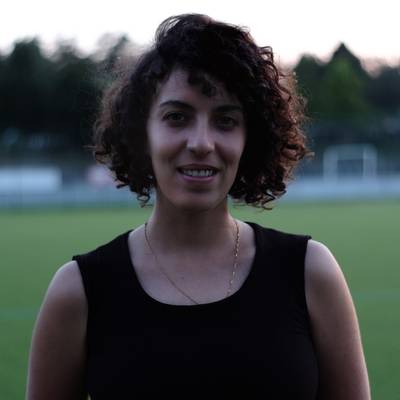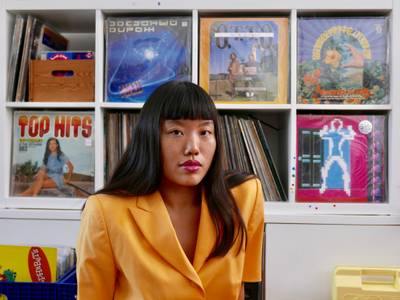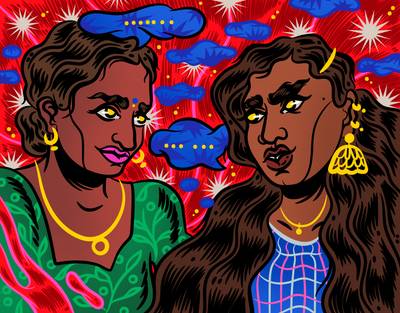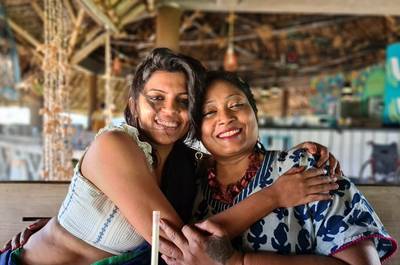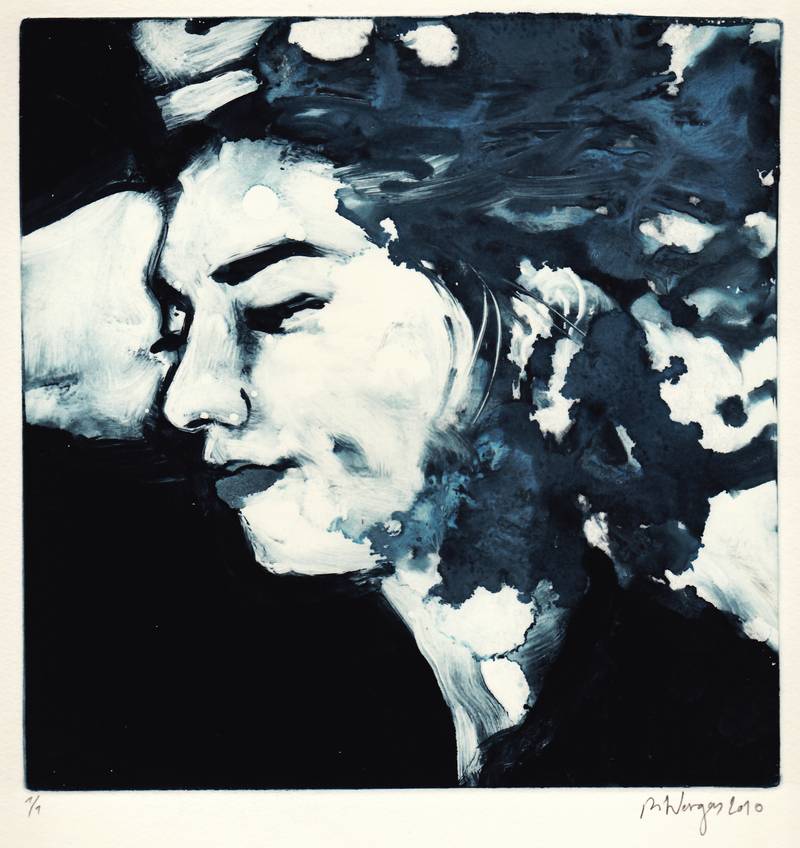

Self-Portrait, 2010. Monotype on Hahnemühle paper, 300g/m2, 100% cotton, acid-free. Paper size 40 × 30 cm, image size 19 x 18 cm.
Jakub Bobrowski is currently learning traditional crafts: weaving wicker baskets and textiles, ceramics and others. He finds working with his hands therapeutic and likes to use materials that can be found in our surroundings. He’s working now on making edible books printed with linoleum blocks.
I’m very enthusiastic about traditional printing methods, so I was happy that Rita agreed to meet in the printing studio that she has established in Vallila, Helsinki, so I could see the premises. Even though we met for the first time, Rita was keen on opening up to talk about a variety of subjects. We talked about many things, stopping longer on the role of Renaissance in Rita’s current art practice, her PhD on artists-in-residence, the latest exhibition in Myymälä 2 and the invisibility of foreign artists in Finland.
“I could lay on the floor of the Sistine Chapel for hours looking at the ceiling.”
JAKUB BOBROWSKI: Apart from establishing the printing studio and running it, you are also continuing to develop your individual art practice. The portfolio link on your website sent me to your Instagram, where I could see some of your latest works. I must say that what drew my attention immediately was your interest in the Renaissance, which is visible in some of your works and that you mention in your texts. It caught my interest because it is really not something I encounter often in the contemporary art scene.
RITA VARGAS: Renaissance is the only time in art history where it is possible to continuously learn and get inspired. There is a certain manner of expression and taste that attracts me somehow. It is a strong inclination towards anatomy, sensuality of gesture, poetry, and mythology. Also, there is a strong connection with Christianity. However, I am looking at and feeling these stories from a contemporary perspective. The way the body is positioned in space is very interesting. The way tri-dimensionality is portrayed in a bidimensional wall and/or ceiling by artists like Michelangelo, for example, at the Sistine Chapel in the Vatican, is something out of this world. I could stay there for hours looking at that ceiling, if only it would be possible to sit and lay down on the ground without being crushed by tourists’ feet, constant noise disturbance, and hidden cameras. There is almost a kind of anxiety about learning by seeing, and in fact, after traveling and researching in Rome last October, my ability to draw and carve lines also changed. They became more certain and clear in their search for direction. There is an interest in how a certain line or value is done, why and how certain colors are used, and the understanding of their symbolic meaning. The viewers can look at the image at the same time and they can relate it to many aspects of their own lives. Somehow, I always keep returning to the masters who made that time in the history of humankind so special in the arts scene. I’m mostly referring to the western art scene, which I’m more familiar with.
Because I was born, educated and academically trained within these French, Italian and Flemish aesthetics, of course it influenced the making of artwork as well. Adding the fact that my town of origin has more than 100 churches, and during part of childhood, I have been in constant contact with religious art and architecture from the middle ages. It is like a little Rome. In fact, there is a Roman temple!
What’s the city?
Évora. The University of Évora is about 500 years old, and I was studying under frescoes at its main library. The tax office is situated in a Renaissance building where there are frescoes everywhere. But with the experiences in Japan, Germany, England and from living here in Finland, things have changed. I have been influenced a lot, but more in the way I use color than in the way I use the line.
“The main aim of the writing was to help other artists”
OK, to talk about something different now. I started to read your PhD thesis…
(dropping her hand she was supporting her head with on the table, hanging her head down and making big eyes in disbelief)
I mean it is publicly available and there is a link to it on your website so don’t be so shocked (both laughing).
Oh God… (shaking her head still in disbelief)
From the title International artists-in-residence 1990–2010: mobility, technology, and identity in everyday art practices and the abstract, I didn’t expect it to be, at least from what I read in the first pages, on one hand very scientific and on the other very poetic. It was interesting for me to see how seamlessly you can combine these qualities…
It was my supervisor, Professor Annika Waenerberg, she’s my hero, we did a great job together. I think the whole department is amazing, the Dept. of Music, Art and Culture Studies, University of Jyväskylä.
I didn’t expect that writing on artists-in-residence would touch so directly on the themes of home, belonging, how it is for the artist to be moving, engaging with the new place while carrying objects that signify home somehow… I found that I was connecting to it a lot, perhaps because it seems to me that these things you touch on are also concerning artists moving to live in another country.
I feel very happy that you have connected to it because the main aim of the writing was to help other artists. Actually, that was a pioneer study, the first doctoral dissertation in the world to grasp the phenomenon of artists-in-residence. Only after it was published the interest, research, and documentation in this field started to boom as well. I began to notice websites such as resartist.org and transartists.org developing more accurate information for artists too, to give them more support in making the decisions that need to be made before applying to places.
By dealing with mental and physical well-being alone, I realized how important it is to study, research, and provide tools for improving changes and understanding choices when working temporarily abroad.
Like…
For instance, what kind of residency do I want? Do I want a collaborative residency, a productive residency, a thinking residency, a networking residency, an isolation residency, or something else? There is a big business around it. Before, there was nothing. When I started going to artistic residencies, there was nothing. I left my job as an art teacher in one of the most wealthy areas of Lisbon because I was selected to go to Japan. But when I applied for it, things written on the website of the host institution were slightly different from reality. There was a big initial cultural shock, no respect at all for my individuality as a person or for my culture. For example, it was necessary to sign a contract stating that it was not possible to make any political art. It felt horrible at the time. Despite all that, I did learn a lot about how to live in and adapt to such a wonderful and unique culture. By living abroad in isolation for one year in Japan, it became very clear what kinds of difficulties and learning processes artists can go through. By dealing with mental and physical well-being alone, I realized how important it is to study, research, and provide tools for improving changes and understanding choices when working temporarily abroad. It was necessary to investigate why we feel scared and uncertain and how this study can help other artists go through these doubts. The study was very difficult in the beginning because there was no documentation, there was nothing but very few articles written about the phenomenon of artistic residencies, not necessarily on artists-in-residence. I started to investigate research on intercultural communication, psychology, and sociology studies of minorities and their integration, for example, in the United States. From a voluntary exile perspective, I went through all of these studies to understand human adaptation into other cultures, taking into account as well the environment of a temporary artistic residence. The results showed that the artists, whether they are Finnish, Japanese, or Portuguese, are feeling the same thing; they face the same problems. They’re getting out of their comfort zone to go to another place. There are things they take with them and things they work with.
Do you mean things they encounter upon arrival and have to figure out, or some coping tools they come with or develop?
Both. These artworks can be either taking place in situ or years after, depending on how each of these artists is processing their ability to work internally with either geographical or psychological changes. There is always a combination between their own culture and the other culture where they arrive. The analysis was very interesting because it was possible to understand what hybrid identity means in this context, and the term was used as a visual analogy to interpret artworks and/or creative processes. For example, there was one Japanese artist, Midori Mitamura, who did “Mitamura’s Art & Breakfast.” Her performance concept consisted of giving breakfast to the visitors every morning, at the gallery, at a certain time. All the rituals of making the breakfast and putting the flower in the center were related to her own way of keeping her feet on the ground, her own way of bringing up her own cultural identity. Traditions such as ikebana flower arrangement and the tea ceremony were clearly evident. It was as if she was exploring how she could bring her own culture to another place, in another context, adapting to a new environment.
“My mountain can be your iceberg”
“With Torn I try to silently bring a loud sensation of not being able to belong to a place, at the same time that familiarity is present.”1
I would really like to talk about your exhibition in Myymälä 2. It has a strong title…
Yes, Torn…
It makes me think of the divide. As we talked about hybridity and trying to keep our feet on the ground when arriving in a new country or new life circumstances, this makes me think of having one foot in one place and the other in another and how you balance that.
Yeah, exactly…
The image of the mountain is the one that advertises the exhibition and, to my mind, relates in the strongest way to the title and the description of the exhibition. It seems to evoke several things. It is part of the landscape, as you explain in the description, and in a way, it is like this object that signifies home that you take with you when you move or travel, because your family gathers at that site every year, so I would imagine it can evoke this feeling of connection to the land, people, culture, all of that…
It can also be more universal; it can represent a fragment of a landscape in your land, and another person may look at it and think, “Oh, this is like my iceberg, or something else entirely.”
Cyanotype gave me the possibility to discover new tonalities in a way that satisfied the eye, in a quality that satisfied the surroundings of the mountain too. That coastline is foggy… and each print, due to its unique exposure time and hand-developing methods, recalls the characteristic fogginess of that seashore as well.
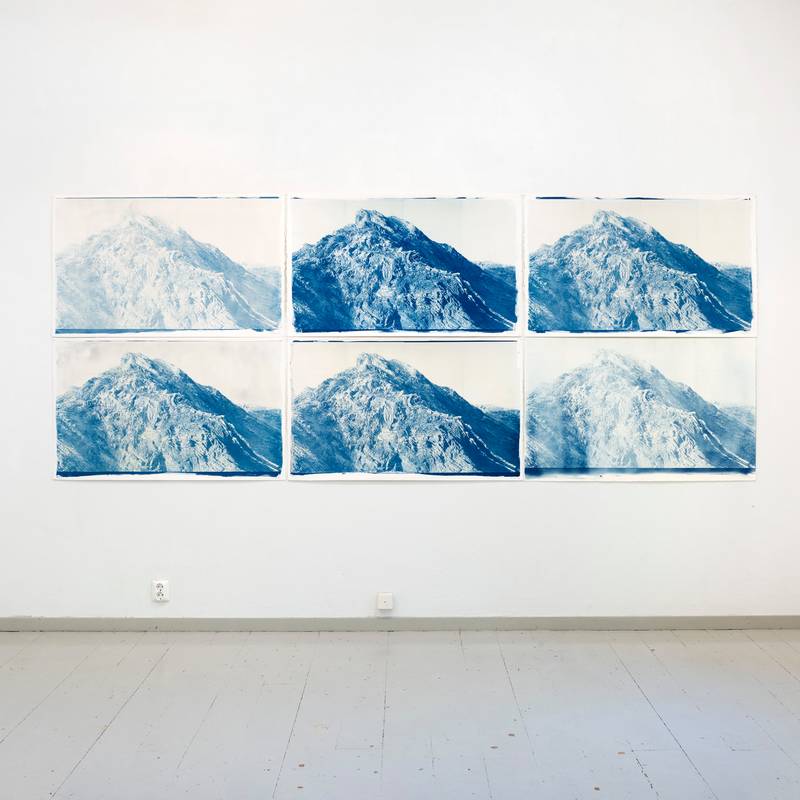

Torn, 2021. Cyanotype on Arches watercolor paper, natural white, 356g/m2, 100% cotton, acid free. Installation view at Galleria Becker by the occasion of “Affection Adrift” exhibition, Summer 2021. Photograph by Maija Holma.
Yes, this is a familiar thing for me, being away and longing for a landscape and everything it takes you to. And the edges of this mountain are torn… Would you like to elaborate on that work and how you decided that that’s what you wanted to address and exhibit? Also, regarding the use of the cyanotype as a technique.
I can bring you here (we move towards the drawers). Been doing this work for the last ten years. All of them (we are looking into a drawer full of prints) are only of that landscape, so the mountain is also from the same coastline. Technically, these are etchings. One is from 2016 and another from 2019, from the same plates, reworked and reworked all the time. This is the non-commercial part of my work, very randomly shown. Working in this studio has allowed me to focus because there are not so many people around me moving and asking questions. Previously, in the other studio in Jyväskylä, there were constant interruptions because it was a studio where many artists were working (including international artists-in-residence) and people were doing it as a hobby. When working here, at my studio, it was possible to look at ten years of photographs taken of this landscape and later explore them with different methods, such as cyanotype. Before, etching facilities were more handy in Jyväskylä, at the Ratamo Center of Printmaking and Photography. Here, at Vargas Print Studio, it has been possible to create that mountain on a larger scale, in a more peaceful way. Intaglio and silkscreen printing have not been enough to express exactly what I felt on that Portuguese coastline. Cyanotype gave me the possibility to discover new tonalities in a way that satisfied the eye, in a quality that satisfied the surroundings of the mountain too. That coastline is foggy… and each print, due to its unique exposure time and hand-developing methods, recalls the characteristic fogginess of that seashore as well. The Torn exhibition is born out of the ten years of attempts to express that mountain.
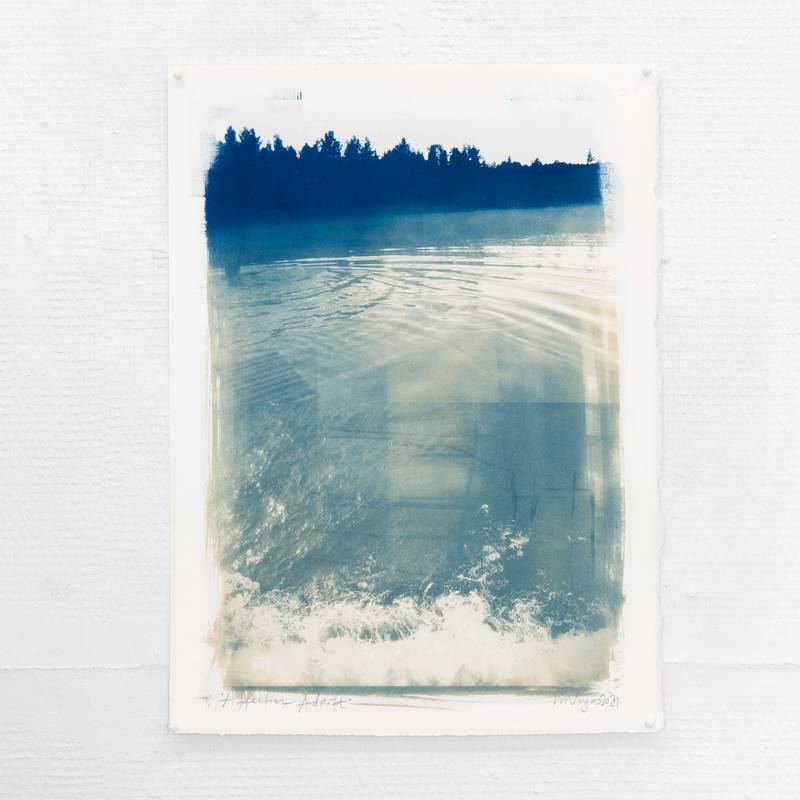

Affection Adrift, 2021.Toned cyanotype on Arches watercolor paper, natural white, 356g/m2, 100% cotton, acid free. Paper size: 42 x 31 cm, image size: 38 x 27 cm. Photograph by Maija Holma.
I must confess, I was not familiar at all with that technique until I went to your webpage and then I read that it is a photographic printing technique from the mid nineteenth century that is still being practiced today, with its characteristic blue tones.
Yes, it’s practiced a lot, and it’s funny because there are also other artists in Finland, also students, that work with this technique, but they get so much more visibility.
“It is better that I smile against some kind of hostility, or show my middle finger when being yelled at to go away, with my son next to me.”
Is that what you meant in the email when you mentioned that you’d like to talk about the invisibility of the foreign artists in Finland?
Because of the language, of the communication process, and the flow, it is so much easier to invite someone who speaks your language to an exhibition. Even if it’s a museum, gallery, or cultural institution, it’s more natural to invite a friend than to invite people you don’t know and have no idea about. It is scary, isn’t it? But of course, the way that the host community is embracing or selecting others is something that you can’t control. You can control only yourself.
How do you deal with that? What kind of solutions are you finding?
There seems to be no solution other than working every day with the tools and possibilities you have in hand, without getting the nerves to take over your system. After recovering from severe depression, I understood that the problem was not with me. From hundreds of working applications and emails sent to museums, galleries, artists’ associations, and people that have been working [same atelier] with me for 10 years, the answers have been constantly the same, it is so sad. For example, a) Your mother language is not Finnish and you don’t speak Swedish; b) We cannot pay you; c) You are too old and you do not have experience; d) Unfortunately, you are a mother; e) You have to leave the application form in the website recruiting system (never worked); e) We only hire high quality artists that are recognized by the Finnish society as such; f) When I start speaking on the phone, they notice my Finnish and hung up in the middle of my sentence; g) You can send me your ideas, but we can’t hire you; h) I don’t need your papers (throwing my CV aside)…and sorry I forgot the meeting; i) No email response; j) I prioritized the Finnish applicants; k) You are overqualified; l) We don’t have an “open” studio… It is better that I not mention names, institutions, and colleagues (yes, colleagues, also foreign colleagues who are in a position of hiring or power). It is better to not say #metoo. It is better that I remain silent when people spit at my back, or pick my bike and throw me on the icy road where cars pass. It is also preferable that I remain silent when people stare at me from head to toe, as if I were a monkey in a cage (Yes, I do have a slightly more hairy appearance). It is better that I smile against some kind of hostility, or show my middle finger when being yelled at to go away, with my son next to me. There are hostilities everywhere in the world, and it was my choice to come here to Finland-this is a voluntary choice. Without Finland and its supportive social system, I would not be able to raise my child as a single mother in a safe environment free of drugs, violence, and human trafficking. In Finland, it was possible to conduct research in a great academic environment and defend a doctoral thesis (with a Portuguese grant from the Foundation for Science and Technology, though). In Finland, we have a roof, food on the table, simple things such as a table to work on, a bed, a shower, and my child is healthy.
I will continue questioning people directly about their choices and inability to accept foreign knowledge, experience, and culture. People who know me know that I am not scared to speak about how it feels to be a foreigner in a foreign country.
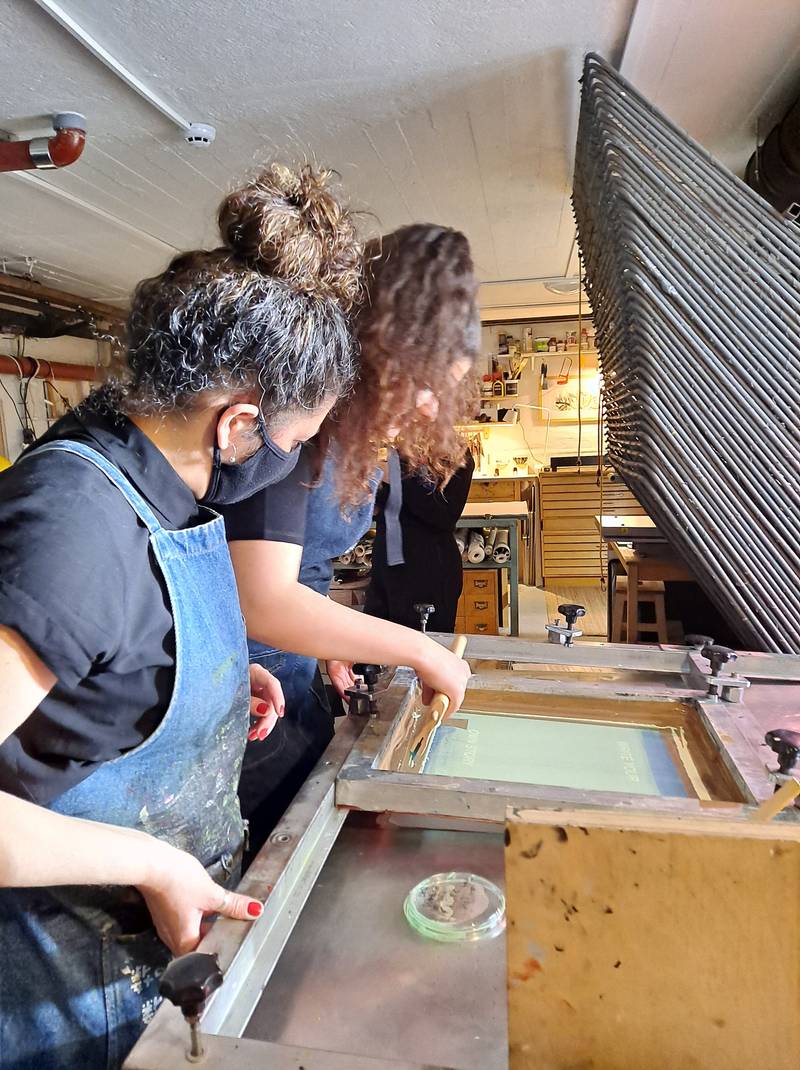

Silkscreen printing session for Kauas Creative Agency. Photograph by Misael Sine.
So far, it has been possible to get psychological support when needed. It takes months, but still. If it were not for my son, great friends (Finnish friends included) and my clients, who continue to support my art and my business every day in one way or another, I would not be able to live. For that, I am deeply grateful. However, I will continue questioning people directly about their choices and inability to accept foreign knowledge, experience, and culture. People who know me know that I am not scared to speak about how it feels to be a foreigner in a foreign country. However, I choose my mental health in order to raise a child properly, protecting him from hardship. For that, it is better to stay out of drama and focus on learning more skills to pass on. I am not writing laws, nor do I have the capacity to change them in practice. I can’t change the entire system on my own. I am a human being with the skills and abilities to create a world where people can dream and focus on their wellbeing. This is a choice. With art, it is possible to reach people in many ways. With academic research and scientific work, it has been possible to help other artists who are going through immense changes. My contribution to humankind is there, open access. If there are people who need advice and help, they know where to find me. Welcome. There is tea, coffee, and perhaps a bit of chocolate, if there is any left!
